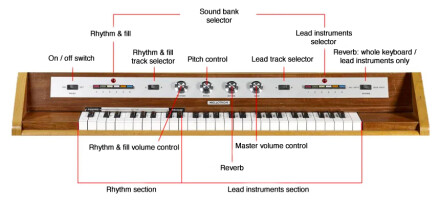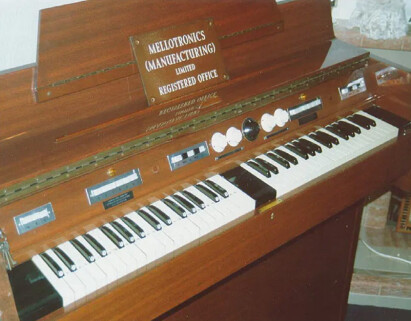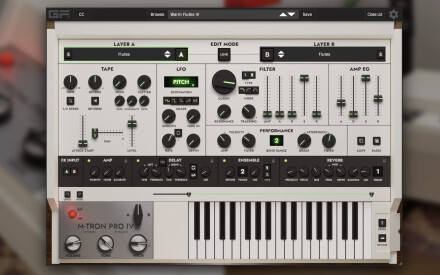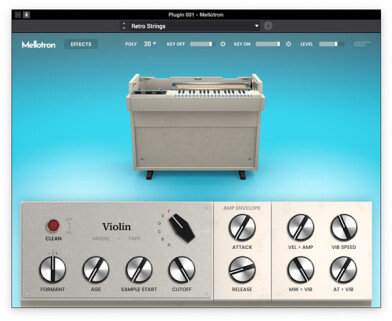Paul McCartney and the Gallagher brothers all play it. But while the existence of the famous tape keyboard has had a profound effect on the history of English rock, it is in the United States that the instrument has its roots.

Who are you, Mellotron?
Before we get to the heart of the matter, we need to know what we’re talking about. Popularized in England in the early 60s, the term Mellotron encompasses a series of instruments capable of reproducing the sounds of acoustic instruments: flutes, drums, violins, and even very complete arrangements. Mechanically speaking, forget oscillators or transistors; the Mellotron operates on a system of magnetic-tape coils, in which each key on the keyboard has its own length of tape. The tapes containing the sounds are, therefore, not loops; they are linear tapes that are always played back from a fixed starting point.
The origins: Chamberlin’s discovery
While the Mellotron is more associated with the musical ferment of the '60s, few listeners suspect that the first version of the instrument was born just a few years after World War 2. Riding on the popularity of plastic magnetic tape in the '40s, inventor Harry Chamberlin developed the first model of electromechanical tape keyboard at his home in California. Listening to a recording of himself playing the organ, it clicked: why not create an instrument capable of recreating great acoustic instruments easily from home so that families could cover standards from their living rooms without great expense?
Following through on his idea, he set off, in 1949, to record an orchestra to bring to life the components of his first creation: the Model 100. At this stage, the instrument featured a length of tape anchored at one end, passing over a set of spring-loaded serpentine rollers, then over a tape-reading head and capstan. When the key was released, a spring-loaded mechanism returned the tape to its starting point. In this way, playback always started at the same point on the tape to realistically reproduce the attack and sound of the recorded instrument. Finally, a capstan motor speed control enabled pitch adjustments and variations, the only way to truly modify the sound.
Gradually, and in line with the growing commercial success of his business, Chamberlin developed new, more sophisticated models. The Model 300 featured a keyboard of nearly 35 notes with three tracks on each band, as well as a cycling system that allowed the band to move forward and then backward to change the sound. In 1962, the sixth version of the Chamberlin was a two-manual (double keyboard) unit with a side-by-side tape mechanism. But just as the business was going well, and Chamberlin had moved from garage to factory, the inventor was betrayed by the ambition of a co-worker.
Demo featuring several sounds from the M-1 Remote Chamberlin © Sound Space Audio
English adventure
Chamberlin’s little business was doing well in the early '60s, but it remained relatively unknown to the general public, and instruments were mostly sold by word of mouth. A guy named Bill Franson was well aware of this. Formerly the inventor’s window washer, then a salesman for him, Franson sensed the invention’s potential. In 1962, he disappeared with two M600 models under his arm and headed for England. When he landed there, he removed the “Chamberlin” signs from the machines and set off in search of collaborators to develop a new, more efficient model and market it in the UK. In Birmingham, he teamed up with engineers from Bradmatics and founded Streetly Electronics. Together, they launched the first real Mellotron: the MK1 (below).
This is the real turning point in the history of the instrument. The English company corrected most of the shortcomings of the model created by Chamberlin. Indeed, the American inventor’s instruments were designed in a rather haphazard fashion. The aesthetics of the cases were simplistic, with controls haphazardly placed without logic and captioned by hand or label tape. Some models had amps powered by 9V batteries that had to be changed constantly. What’s more, the wiring on some models was connected to all the metal components on the units, making maintenance of the units very tricky, if not dangerous.
In the mid-60s, Chamberlin learned of the deception and took legal action against Streetly Electronics. The case ended in an out-of-court settlement with royalties paid to Chamberlin for each model sold, a guarantee that Chamberlin would keep control of sales in the US, and even collaborate on recording new instruments. On the Mk-1, the famous “Three violins” sound featured in David Bowie’s “Space Oddity” (1969) or Led Zeppelin’s “The Rain Song” (1973) was recorded by the American engineer.
After the golden age, back to calm
After the disputes were settled, the business quickly picked up again with Streetly Electronics’ 1968 launch of the M300, a single 52-key keyboard combining lead and rhythm. A year later, the M400 caused a sensation. In line with musicians’ demands, the new instrument was lighter and easier to transport, and rhythm was removed from the sound bank in favor of more leads (the sounds preferred by musicians at the time). The M400 is thus a relatively small and practical instrument with a single 35-key keyboard. In the history of the Mellotron, it is by far the most successful model in terms of sales (over 1,800 were built at the time).
In the late '70s, Streetly faced a new obstacle. Due to a trademark disagreement with their American distributor, Streetly lost the rights to use the “Mellotron” trademark. Undaunted, they went ahead and renamed the product “Novatron.” In 1977, they launched the Novatron Mark V, followed by the Novatron M400 in 1978, which was essentially the classic M400 with a new moniker. Gradually, their sales declined due to a lack of interest from musicians, who were already caught up in the sampler craze.
Officially, Streetly closed its doors in 1986. Since the late '90s, the Mellotron brand has risen from the ashes. Streetly was revived, first to service and maintain the instruments, then to build new ones starting in 2007.
Modern times
In 2010, a compact digital version of the iconic instrument, the Mellotron M4000D Mini, was released. It retains the authentic sound, look and feel of the original keyboard while adding some significant enhancements. It features a rich sample bank and 100 original Mellotron and Chamberlin sounds.
Price: €2299/$1999
To find it: https://fr.audiofanzine.com/synthe-numerique/mellotron/mellotronm4000d-mini/
A Mellotron without a Mellotron: the software
When it comes to software, it always seems as if we’re spoiled with choices. However, when it comes to recreating the sound of a Mellotron, there are relatively few good options. Here’s a quick look at the options available.
1. Gforce M-TRON Pro
Considered the software alternative with the most faithful sound rendering to the instrument, the MTRON Pro boasts a massive 3.5 GB sound library and includes over 700 patches.
Price: €209.99/$189.99
2. Arturia Mellotron V
Arturia needs no introduction. Taking the lead from the best software emulations of classic analog keyboards and synthesizers, Arturia’s Mellotron V gives you the ability to touch every aspect of the instrument to your heart’s content. You’re free to fine-tune every aspect of your sound, variable instrument mix combinations, tape flicker, saturation and inherent noise.
Price: €149/$149
3. Mellotron from AIR Music Technology
A little cheaper than the other two, this plug-in is a good option for getting closer to the sounds of the original instrument, with six tape sets, including Flute, Choir and Strings tape samples. In all, you have some thirty presets to re-tweak as you please by manipulating the pots.
Price: €100/$99.99
The Mellotron in five titles
1. The Beatles, “Strawberry Fields Forever” (1967)
We don’t need to introduce you to this classic, in which the Mellotron plays the protagonist right from the introduction with a psychedelic flute sound that puts the listener on Cloud Nine.
2. David Bowie, “Space Oddity” (1969)
In Bowie’s case, the Mellotron is used to create the string sounds, which help create that spacey, unearthly ambience as the song progresses.
3. Led Zeppelin, “Stairway to Heaven” (1971)
From Jimmy Page and his acolytes, it’s also in the introduction that it happens with this flute sound, bringing this mystical and ethereal dimension to support an inescapable riff.
4. Radiohead, “Exit Music For a Film” (1997)
On their album “OK Computer”, Radiohead uses the Mellotron to force the line of the song’s strange, haunting atmosphere, particularly with choir sounds.
5. Childish Gambino, “Redbone” (2016)
Is fashion an eternal do-over? Fifty years after the golden age of the Mellotron, we find it again with Childish Gambino creating big, lush waves of strings that provide a warm, vintage texture throughout the song.








